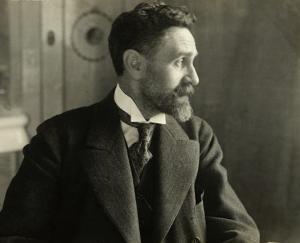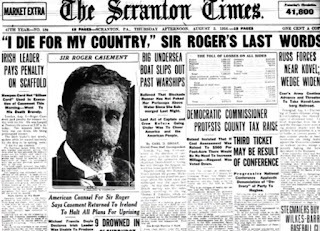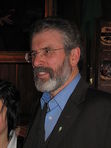Roger Casement I have spent manyenjoyable afternoons in ...

Roger Casemen t
I have spent manyenjoyable afternoons in Casement Park watching countless football and hurlinggames and playing in some of them. I have lost count of my man of the match triumphs. Especially for St. Marys or BelfastSchools in hurling. Or on Sports Days. In the past thestand and terraces or raised mounds aroundthe pitch provided a wonderful view of the contests. Some games attracted a fewhundred spectators while others were watched by enthralled thousands.
Casement Park wasopened in June 1953 and was named after Roger Casement. He was one of theleaders of the Easter Rising of 1916 who was hanged in London by the British inAugust that year. The people of Belfast, but especially the west of the City,raised over one hundred thousand pounds to construct Casement Park.
For much of its 71years Casement has been at the heart of the west Belfast community. At onepoint classes for primary school children were held under the stand. On the 50th anniversaryof the Easter Rising in 1966 a huge and colourful pageant was held in Casementto mark that historic moment in Irish history. For a time after OperationMotorman in 1972 it was occupied for more than a year by the British Army. Rallies in support of the hunger strikers were held there also.
For the last 8years it has lain empty and silent as a legal battle was fought over planningpermission for a new 34,000 seat stadium. That process is now at an end andlast week the first steps were taken to allow construction work to begin. Thedecision by the Irish government to allocate €50 million toward theconstruction is a very welcome development. The hope is that the new CasementPark will rise phoenix-like within the next three to four years in time to hostthe Euros in 2028.
These exciting newdevelopments got me thinking about Roger Casement. Who was this Dublin man whofound a home in North Antrim and wanted to be buried at Murlough Bay nearBallycastle?
Casement was amember of an Ulster Protestant family, a Knight of the British Empire and aBritish diplomat. He was also a gaeilgeoir who loved the Glens of Antrim. Hewas proud to be Irish. He was a thinker who took many of the weightiestdecisions of his life whilst pacing on Cushendall beach. He was resolute in hisopposition to British rule in Ireland and his goal was a free, united andindependent Ireland.
Casement came toNorth Antrim after his mother died when he was nine. His father decided tobring the family back from England to live near relatives. His father died inBallymena when Roger was 13. Roger remained in Ballymena, going to what laterbecame Ballymena Academy. He moved to England at the age of 16 and eventuallyjoined the civil service.
In 1903 he wasasked by the British government to produce a report on the conditions in aregion of the Congo controlled by the King Leopold of Belgium. Rubber and ivorywere the main produces. Indigenous workers were being mercilessly exploited.Millions died from exhaustion, hunger and disease. Casement’s expose of thecruelty of Leopold’s activities created an international outcry which led toLeopold being stripped of his control of the Congo.
Later Casement wassent to South America where he investigated the use of slaves and theill-treatment of local native people by a British rubber company. In 1911, forthis work Casement was given a Knighthood by the British. However, hisexperience had also opened his eyes to colonialism.
Two years laterCasement helped establish the Irish Volunteers. He travelled to the USA toraise money for that organisation and was involved in the smuggling of Germanweapons into Howth in July 1914. Casement negotiated with the German governmentduring the First World War for more guns and assistance for the plannedrebellion. He was arrested by the British at Banna Strand in County Kerry inApril 1916 three days before the Rising took place.
He was taken toLondon where he was initially held in the Tower of London. Casement was viewedby the English establishment as a traitor. He was tried for treason and hanged onAugust 3rd 1916. In his famous and powerful speech from theDock Casement lambasted the English establishment. For England, he said … “thereis only England; there is no Ireland; there is only the law of England, noright of Ireland; the liberty of Ireland and of an Irishman is to be judged bythe power of England.”
Addressing thedivisions created by English governments Casement said that IrishRepublicans: … “aimed at uniting all Irishmen in a natural andnational bond of cohesion based on mutual self-respect. Our hope was a naturalone, and if left to ourselves, not hard to accomplish. If external influencesof disintegration would but leave us alone, we were sure that nature itselfmust bring us together.”
And onthe right of the people of Ireland to independence and sovereignty RogerCasement told the court that condemned him to death that: “Self-governmentis our right, a thing born in us at birth, a thing no more to be doled out tous, or withheld from us, by another people than the right to life itself — thanthe right to feel the sun, or smell the flowers, or to love our kind. It isonly from the convict these things are withheld, for crime committed andproven, and Ireland, that has wronged no man, has injured no land, that hassought no dominion over others — Ireland is being treated today among thenations of the world as if she were a convicted criminal.”
In a letter to hiscousin Elizabeth ‘Eilis’ Bannister dated 25 July 1916 from Pentonville PrisonRoger Casement wrote: “Don’t let my body lie here – get me back to thegreen hill by Murlough – by the McGarry’s house looking down on the Moyle –that’s where I’d like to be now and that’s where I’d like to lie.” In1965 British Labour Prime Minister Harold Wilson agreed to the return ofCasement but only to Dublin. He was buried in Glasnevin Cemetery. The newCasement Park will be a fine tribute to a great patriot. Let’s get it built.

Starvation
There is now overwhelming evidence that the Israelistate has added a new weapon to its arsenal of genocide against the Palestinianpeople – hunger. The video and photographic images of starving children anddesperate parents searching for food and water are heart rending. The UNsays some 2.3 million people in Gaza are now on the brink of starvation.
Palestinian peoplehave been filmed eating grass in northern Gaza as emaciated children carrybowls hoping for some food in southern Gaza. There are reports of babies dyingfrom acute malnutrition.
We Irish have ourmemory of An Gorta Mór - The Great Hunger of 1845-52 - and of starving peopleeating grass. Some call it the Irish Famine but in a famine there is no fooddue to some natural catastrophe. In Ireland there was plenty offood. During those years the quaysides of Limerick were lined each day withabundant produce including pork, oats, eggs, sides of ham and beef––all boundfor export.
The reality andirony of this is appalling and was aptly described by George Bernard Shaw inhis play “Man and Superman.” The character Malone says: ‘My father died of starvationin Ireland in the Black 47. Maybe you’ve heard of it?
Violetreplies, ‘The Famine?’
‘No’, saysMalone ‘the starvation. When a country is full of food and exportingit, there can be no famine.’
And so it is in theGaza Strip. There is plenty of food waiting in food trucks. More will be sentbut the Israeli state is deliberately blocking these. Starvation and hunger arenow part of its strategy to kill Palestinians and drive them from their land.It cannot be allowed. Ceasefire now. We are all Palestinians.
Gerry Adams's Blog
- Gerry Adams's profile
- 29 followers



